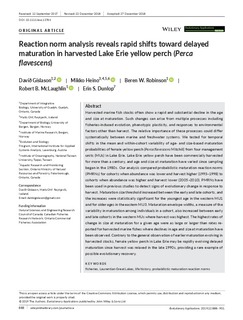| dc.description.abstract | Harvested marine fish stocks often show a rapid and substantial decline in the age and size at maturation. Such changes can arise from multiple processes including fisheries‐induced evolution, phenotypic plasticity, and responses to environmental factors other than harvest. The relative importance of these processes could differ systematically between marine and freshwater systems. We tested for temporal shifts in the mean and within‐cohort variability of age‐ and size‐based maturation probabilities of female yellow perch (Perca flavescens Mitchill) from four management units (MUs) in Lake Erie. Lake Erie yellow perch have been commercially harvested for more than a century, and age and size at maturation have varied since sampling began in the 1980s. Our analysis compared probabilistic maturation reaction norms (PMRNs) for cohorts when abundance was lower and harvest higher (1993–1998) to cohorts when abundance was higher and harvest lower (2005–2010). PMRNs have been used in previous studies to detect signs of evolutionary change in response to harvest. Maturation size threshold increased between the early and late cohorts, and the increases were statistically significant for the youngest age in the western MU1 and for older ages in the eastern MU3. Maturation envelope widths, a measure of the variability in maturation among individuals in a cohort, also increased between early and late cohorts in the western MUs where harvest was highest. The highest rates of change in size at maturation for a given age were as large or larger than rates reported for harvested marine fishes where declines in age and size at maturation have been observed. Contrary to the general observation of earlier maturation evolving in harvested stocks, female yellow perch in Lake Erie may be rapidly evolving delayed maturation since harvest was relaxed in the late 1990s, providing a rare example of possible evolutionary recovery. | nb_NO |
